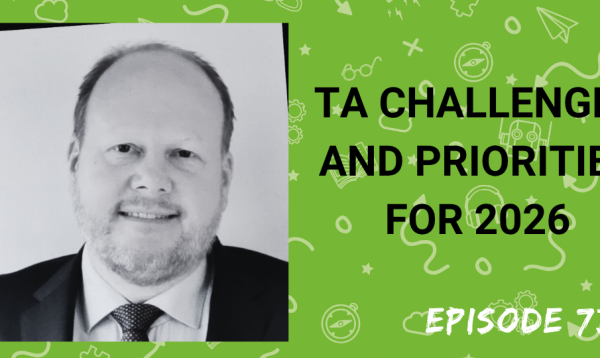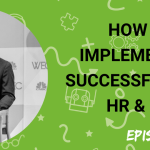The ATS market is growing more complex and becoming potentially more confusing every year. It can also be quite tricky to find meaningful data to make sense of what is going on. Over the last few years, the recruitment marketing tech provider Ongig has researched and published a report on ATS usage which certainly throws some light on the industry.
My guest this week is Ongig CEO, Rob Kelly. As well as talking about the ATS research as a bonus Rob also shares his insights on producing dynamic and effective job descriptions for corporate career sites.
In the interview we discuss:
• The Ongig Top 100 ATS 2018 Report
• The shifting market share from established towards newer providers and why this is happening
• How Applicant Tracking Systems are changing
• Integrations, partnerships and consolidation
• Rob’s tips for creating dynamic career site job adverts
• Transparency and the employer story
• Building commitment step by step on career sites
Rob also talks about the significance of Google’s entry to the ATS market and shares his thoughts on the future
Subscribe to this podcast in iTunes
Transcript:
Matt Alder [00:00:00]:
Support for this podcast comes from Monster. Monster takes your open positions to hard to reach passive candidates on Facebook, Instagram, Twitter and hundreds of sites across the web. While their Swipe right mobile app presents active job seekers with the most relevant opportunities and can increase mobile applications fourfold. What’s more, Monster inspire customers to attract diverse talent and grow their employer brand. To find out how Monster can help you find, manage and champion the talent you deserve, visit monster.co.uk bettertalent that’s monster.co.uk bettertalENT monster in your corner.
Matt Alder [00:01:06]:
This is Matt Alder. Welcome to episode 120 of the Recruiting Future podcast. The ATS market is growing more complex and potentially becomes more confusing every single year. It can also be quite a challenge to find meaningful data to make sense of what’s going on. Over the last few years, recruitment marketing tech provider ONGIG has researched and published a report on ATS usage which certainly throws some light on the industry. My guest this week is ongig CEO Rob Kelly. As well as talking about the ATS research as a bonus, Rob also shares his considerable insights into producing dynamic and effective job descriptions on company career sites.
Matt Alder [00:01:56]:
Hi Rob and welcome to the podcast.
Rob Kelly [00:01:58]:
How you doing Matt?
Matt Alder [00:02:00]:
Yeah, very well. Very well indeed. Could you introduce yourself and tell everyone.
Matt Alder [00:02:05]:
A little bit about what you do?
Rob Kelly [00:02:07]:
Sure. I am Rob Kelly, CEO of ongig and I’m here in the United States. Grew up in New York City. I have a passion for business. My dad was lucky enough to study under Warren Buffett’s main mentor at Columbia University in New York City. And so I grew up on business and Warren Buffet and Buffet isms and thinking long term. And over the years I started off as a journalist, as you know, and I fell in love with recruiting because of the value of human capital, the value of a good hire. I just call a hire a million dollar transaction and it’s actually been proven that the best hire in your next hundred could be worth $30 million a year in revenue. And so I created ONG because I believe every job description, job advert, job opportunity is a multimillion dollar transaction potentially and it deserves a Super bowl job ad. And that’s how I created ongig. And there’s a lot in between there. But look forward to dive in and chatting with you about recruiting today.
Matt Alder [00:03:23]:
Absolutely. And for people who are not familiar, could you sort of tell us a little Bit more about what ongig actually does.
Rob Kelly [00:03:30]:
Sure. So our mission is to transform job pages, job descriptions, job adverts, and we’re talking about digitally, right? Not the old printouts. We do that through a number of ways. One is that we create for employers who are our clients. They’re top employers in the world and we create dynamic job descriptions. They’ve got video, a gallery of pictures, they’ve got chat if you want to add ratings and reviews from Glassdoor or anywhere else all onto a job page, all through software, all done at scale. So literally with a drag and drop, you could take the job description coming out of your ATS and add pictures, video chat, these other recruiting widgets is what, what I call them. And we also have got AI based job search on your career site. So if you want the candidate to have intuitive search where they can search on concepts through your job descriptions, they can even misspell things. They could do shorthand, like SW dev instead of software developer, AI instead of artificial intelligence, you name it and they’ll find the right job. And then finally, we have a text analysis tool that will analyze the text of your job descriptions, make sure that it’s gender neutral, that you’re not gender biased. Most job descriptions are biased towards being written for men, and that turns off many women, meaning you’re losing some of the top female candidates around. And we also analyze the text for positive sentiment and a number of other things. But we’re everything. Job descriptions. Transforming job descriptions is on GIG’s mission.
Matt Alder [00:05:12]:
Now, one of the things that you do every year, or at least you’ve done for the last few years, is you produce a report on ATS usage. And I’ve seen this a number of times. And this is kind of really why I wanted to get you on the show, to just kind of find out, you know, a bit more about that report and you know, some of the trends and findings that you’re seeing. Could you just explain to everyone what the ATS report is?
Rob Kelly [00:05:39]:
Sure. And you know, you know, content marketing. Well, I know that I’ve seen all your different projects out there and it’s a specialty of yours, so I know you’ll appreciate this. But what we did was our approach to marketing is that we replaced the word sales or selling and marketing with teaching and sharing. That’s just our philosophy. We think good sales and marketing is good teaching and sharing. We’re supposed to be the experts on something. Just like you’re an expert on recruiting podcasts and podcasts in general, I’m sure So what we do is we put out a lot of content. And because ongig partners with Applicant Tracking Systems, atss, we decided to take our own database, our own CRM, and take all of the employers and the ATSS we know that they’re using and publish that in a report. And we took a chance. You know how this goes, you put out 10 pieces of content and maybe one or two really work, if you’re lucky and be popular and valuable. And in this case, it really hit this top ATS report we put out. We summarized the trends of which employers are using which ATSs, the market share of all the ATSs. Who are the new guys on the block, or gals I should say too, in this day of gender neutral language, who are the new ATS on the block? Who’s gaining market share, losing market share? And we put it out annually and we do it just for free. And it helps the community, helps employers, heads of TA figure out the trends and which ATS is to look at. One of the top questions I get from a head of TA is which ATS should I use? Rob, what’s the latest? What’s going on? I’m about to make a big decision. It could be 50, 100k, 200k a year type of decision, depending on your volume to pick an ats. And so we do that data also to make us smarter about what’s going on. And that’s a little bit about the top ATS report, the new one coming out any day. It might have came out already by the time this airs.
Matt Alder [00:07:52]:
Well, exactly. You know, I’m recording a couple of weeks in advance at the moment. So the new one will have either come out or is just about to come, just about to come out by the time this hits the airwaves, as it were. Give us a, give us a preview. What you know, what interesting insights, you know, can you see what’s coming going on in the ATS industry? What’s changing? What are the new developments?
Rob Kelly [00:08:19]:
Sure. Well, one of the things we do, we’re kind of known for all the pie charts and trend graphs that we put on there about who’s got which market share based on in ATS is based on the volume of jobs is how we break it down too. So ATS is for a large enterprise like Disney or Accenture or someone like that is a very different market than an ATS for a startup where you’re just hiring one or two people. We actually cover that full spectrum though, looking at the, on the large size atss in terms of serving large clients. Taleo from Oracle, of course, is still the largest ATS by market share, but they’re really, they’ve lost a bunch of market share to new companies out there. Those new ATSs include companies like Greenhouse Software, iSIMS, Workday. In fact, Workday probably alone has taken the most business from Telayo. But some of these smaller and medium sized ATS are too, which is very interesting.
Matt Alder [00:09:32]:
That’s interesting. It’s interesting to see the growth of those newer businesses. Do you have any insight into, you know, into. You know, I know that you’re obviously just reporting the sort of the data that you’re seeing here, but do you have any insight into, you know, why that might be? Do you think the, you know, is the market changing? Are expectations changing? You know, what are you hearing from the people that you’re talking to?
Rob Kelly [00:09:57]:
Sure, I think, you know, part of this is just the law of numbers. Of course, as you get larger, it’s harder to, you know, to grow the business. But, you know, the ATS has become so critical to recruiting. It really, it’s such an interesting story because it was built, you know, almost 20 years ago. The concept of the ATS was built to track candidates, you know, just to store and manage them. And it’s become, the ATS has become that core center of, of recruiting because it’s, it’s, it ended up being the software that generated the job pages and the job wrecks out there. And so I, I think it’s over the last five or eight years gotten just tremendous attention for its strategic value out there in the software industry. So now of course you’ve got Oracle, runs Taleo and a number of other related ATSs. You’ve got IBM in there with Conexa, you’ve got SAP in there with success factors. And now really the newest version of them is Workday. Which is the reason they started their business is because they saw massive value in the ATS market and human capital management software in general, a ton of attention. And that means a lot more competition. So everyone’s going after the biggies in their various markets because I know this.
Matt Alder [00:11:30]:
Is something that you measured. What’s the difference between what large companies are using in terms of ATSs and what smaller companies are using? Is the picture very different?
Rob Kelly [00:11:43]:
Well, when you get to the large size, there’s a lot more compliance that goes into things. So for instance, here in the United States, if you’re working with the government number one, or if you are a public company publicly traded on a stock exchange, then You’ve got all these compliance rules that you’ve got to adhere to. And so some of these larger ATS has spent a lot of time on that. That’s very important. Some of the newer ATS and ATS is for the smaller businesses that might not need to care about that, call them startups or small medium sized businesses who might not work with the government at all, certainly aren’t public yet. Those ATSs are, and those include companies like Greenhouse, iSims, also lever smart recruiters. Those new ATS are focused a bit more on the marketing of the jobs and the recruiting aspect and also being very, of course, UI friendly, responsive design. So they’re mobile savvy. They also, they’re just newer, so the software has less legacy and is more modern, for lack of better word. That’s very different. As most employers out there know, a candidate searching, looking at a job that’s generated out of Taleo is very different looking than a job that’s generated out of smart recruiters, for instance.
Matt Alder [00:13:23]:
And I think that’s an interesting point and, you know, probably something worth exploring a little bit more because, you know, obviously, you know, your business is all about making the most out of, you know, job adverts and, you know, turning job descriptions into much more sort of dynamic, you know, dynamic pieces of marketing. You know, it seems to me that the majority of companies are just using, you know, using their ATS to, to basically sort of, you know, just churn out very pedestrian text based job advertising. And that appears to be the norm all over the world. Obviously that isn’t going to work as well as, you know, taking a kind of a more dynamic approach to it. What would be your, you know, your tips to people when it comes to job descriptions in terms of, you know, what are you seeing that really works? What do candidates engage with and what really stands out?
Rob Kelly [00:14:22]:
Well, you know, and it’s a great, it’s a great point you’re bringing up because you know, the very name ATS, again, applicant tracking system that ATSs are designed to track candidates, they’re not designed to attract them. Some ATSs try to do that and play in that world, but there’s so much else that a good ATS has to do just to track a candidate and store and manage them. That, you know, my personal view is that ATS is that focus on those core functions of tracking, managing, organizing the candidate are going to be the best ATSs, of course, because they’re truly focused. But if you want to attract a candidate and not just track them and you want to stand out in a marketing way, treat a candidate truly like a consumer, stop them in their tracks with a job page that’s mobile friendly, that’s got media on it, that is engaging, video, pictures, interactivity, actual content. Again, content marketing we were talking about earlier, showing the people that are related to that job opportunity. Who’s the job owner? Why wouldn’t every job description show who the job owner is at the employer? In this day and age, the candidate wants transparency. They want to see right through. They don’t want to work for their parents company that looks like the department of Motor Vehicles, you know, job pages. And they want to sit there standing in line and reading a bunch of text. They want to immediately have a feel and a sense of the story of this company, the employer brand of it. And that’s a very hard thing to do. And ATS is busy with a lot of other features to build. And that’s one of the reasons on Gigs in business is that we transform those job pages with everything I just mentioned and then some.
Matt Alder [00:16:19]:
And out of all of those, all of those features say, you know, you’re an employer and you know, you weren’t in a position to, you know, completely transform your, you know, your job advertising, but you might be able to do, you know, one or two of the things that you mentioned. Which of those approaches are you seeing having the biggest impact or does it, does it really depend?
Rob Kelly [00:16:44]:
Oh no. I think certainly there’s a few things that if you had to focus on transforming your job pages and you needed just a top priority list, I would look at a couple things. One is I would measure the time on page currently for whatever job page you’re serving up, probably coming out of your ats, I would first off, start off and measure that time on average here in the US it’s about 8 seconds or so that a candidate looks at a job page. Job opportunity, normal text based job opportunity, not one of on gig’s client’s job pages. When you put a lot of work into it, you can get a candidate to spend invest 3, 4, 5 minutes on that same job opportunity. Some of our clients have anywhere from two to five or six minutes time on page, which is a key metric. The reason that’s important is that the more a candidate will invest time on your opportunity. In psychology they call this commitment theory. They’re committing a little bit more. Let’s say they watch a video, they’re now about you, just the culture, who you are, your vision as an employer. They’re now they’ve committed that time, they’re committing, they’re taking a step closer to joining your organization. Let’s say you show off the job owner on that page. Could just be the recruiter, could be the hiring manager. You show their LinkedIn profile as all of Vaughn Gig’s clients have with our platform, then the candidate is starting to picture working with that person, maybe even looking at their profile on LinkedIn again, investing time, committing more. So I’d say it starts with that engagement on the job page itself making a truly dynamic job description. So that’d be one. That’s where I would start certainly. And you could move that needle from a candidate spending eight seconds to spending, you know, minutes. It’s like a mini recruiter meeting that the candidate’s having now with you, the employer and your team didn’t have to show up. It’s digitally on a page. You just had to do the front end work. We think that’s radical and just the future. So that’s number one having a dynamic JD Number two is that I would focus on the search on your career site. If you’ve got any volume of jobs, anything more than 20, 25 jobs, you need a kick ass search engine to put on there on your career site. We’re talking about, you know, IBM.comcareers starting there for the candidate. That and you need to do better than the ATS job search. Most of them aren’t just are average. And there’s some AI based artificial intelligence based job search technology. Now ongig has this in our platform that allows the candidate to do things like search a concept. So it turns out candidates don’t just search basic things like sales and technology. For instance, software developers often search shorthand like SW dev for software developer. Well if you go to the Fortune 500 in the US almost every one of them except for Ongig’s clients, if you type in SWDEV in a search box on their career site, you get zero results even if they’ve got 1000 software developer job openings. And the reason is because job search on the career site is mostly keyword only. Exact match or even worse has false positives and brings in a bunch of junk and not relevant stuff. It takes care of misspellings. We call this intuitive search. In general, having an intuitive search engine on your career site, it understands concepts. So it understands software developer in NYC for New York City. It understands that the New York City area includes New Jersey. Some parts of New Jersey are closer to New York City office than other parts of Manhattan. In New York City, of course. Why wouldn’t you show jobs in New Jersey to someone searching on NYC for New York City? It starts to end. The best of all with AI based intuitive search is what I call it. This is cutting edge, very new. Google is leading the way with some technology on this and a couple of others of us. The best part of all of this, Matt, this AI based intuitive search is it gets smarter. So if the candidate searches something and clicks a link to your job, the system knows that that was a good result. If they didn’t click a link, the system knows not to show that result next time. So that’d be number two. And then finally the third part would be text analysis. It turns out that the text of job descriptions are often leaning towards being written for men, for male candidates, and not being written for women. And if you’re interested in really moving the needle and your organization and diversifying your workforce, then doing a text analysis of your job descriptions and picking up where there’s bias would be a top thing I would do because I’ll give you a story. We’ve got a client who sales is their engine. Most companies have one department that really drives the company. It might be sales over@salesforce.com for instance, it might be engineers at Google. And this particular client, sales was the driver. And it turns out that only 28% of their sales hires were women. And so I was talking to the head of sales, I said, let’s analyze your text we used on gig. So it’s able to analyze all of their sales job descriptions. And it turns out that it was biased towards men to the tune of 62%. So I was able to tell this VP of Sales that, hey, you want to move the needle on your sales organization, your sales team? Women have been proven to be at least as good as men at sales. Then let’s neutralize these job descriptions to be gender neutral and you’re going to attract a lot more women. And three months later, we had basically doubled the hiring of women for them.
Matt Alder [00:23:18]:
Final question, where do you see ATS is and job descriptions and the industry in general sort of moving over the next 18 months? So, you know, when you’re doing your report next year, you know, what change would you expect to see? You know, how are things going to, how are things going to kind of shake out over the, over the coming year or so?
Rob Kelly [00:23:38]:
It’s a great question. There’s really two camps that, and I’m generalizing, but two camps have emerged in the ATS world. One is what I would Call One Stop Shopping. These are the human capital management software companies like Oracle, Workday, SAP, IBM, Ultimate Software. They are trying to be One Stop shop with human capital software. Every version of it, every feature. You’ve got them in one camp, let’s call them the One Stop Shopping ATS in the other camp is what I would call Best of Breed ats. And those include folks like Greenhouse Software, Lever smart recruiters and ISIMPs is another one as well. Those are best of breed. And in their case what they’re doing is saying, hey, we’re going to nail the ATS part. But if you want an extra feature, an extra app like video interviewing, or a sourcing tool like Intello, or credit check software from someone else, a third party, then we, the best of breed ATSs are going to let you have that easily, go out and pick the Best of Breed out there off the shelf and plug it into our core ats and we don’t care where it comes from and we’ll just design an ecosystem. And we have designed an ecosystem so that if you’re using Greenhouse software, they’ve got 185 partners, last time we checked. Ongig is one of them, by the way. 185 partners where they make it easy. Greenhouse makes it easy for their clients to go pick something, third party software off the shelf and plug it into Greenhouse. Same with isims by the way, they call it a connector. They have 200 of these third party partners. Whereas if you go over to the workdays of the world and Taleo, they’re really going to want you to use their own software. And it’s pretty hard to integrate a third party piece of software. So these two camps, one Stop Shopping versus Best of Breed, are really, I see them getting divided. They’re two very different camps, very different philosophies. And the head of TA has a really big decision to make when they’re going to invest in one of these ATS on which camp they’re going to join. So that’s one trend. The other trend that we see is that there’s going to be continue to be massive consolidation, just these companies buying each other and it gets real tricky. Even isims I just brought up, they just bought Text Recruit, which is an example of a third party application. So this isn’t black and white. They’re even buying some things to put into their core system. Consolidation is the other big trend that we’re going to see. Just massive acquisitions continuing of small ATS and mergers and so forth. By the way, one final thing, very important to note. Google is now a player in this. Google entered the ATS market with their product called Google Hire. This is a serious player. They’re really initially going after Greenhouse and Lever and Smart recruiters, more startups that they’re going after. But this is Google and they could go upstream very quickly and in a big way. Massive resources. They send out things like a free Chromebook. I got one in the mail. They offer send a free Chromebook. If you just talk to them about becoming a Google Hire client, client of their ats, just for talking about them, you could get a free Chromebook That’s a powerful new competitor on the landscape. Now they’re going after startups, but boy, if they stick with this, they could own this space just like they’ve done with their other software out there. Big companies now use Google software, the Google Suite, G Suite and Gmail and Google Docs and all that. That’s a third trend, Google Hire entering this space. And you’ll see in our top ATS report, they are absolutely gaining market share. They’re making a dent.
Matt Alder [00:27:55]:
Rob, thank you very much for talking to me.
Rob Kelly [00:27:58]:
Fantastic. I really appreciate the opportunity. It’s good to get to know you better.
Matt Alder [00:28:03]:
My thanks to Rob Kelly. You can subscribe to this podcast in itunes or via your podcasting app of choice. The show also has its own dedicated app, which you can find by searching for recruiting future in your App Store. If you’re a Spotify user, you can also find the show there. You can find all the past episodes@www.on that site. You can also subscribe to the mailing list and find out more about working with me. Thanks very much for listening. I’ll be back next week and I hope you’ll join me.








